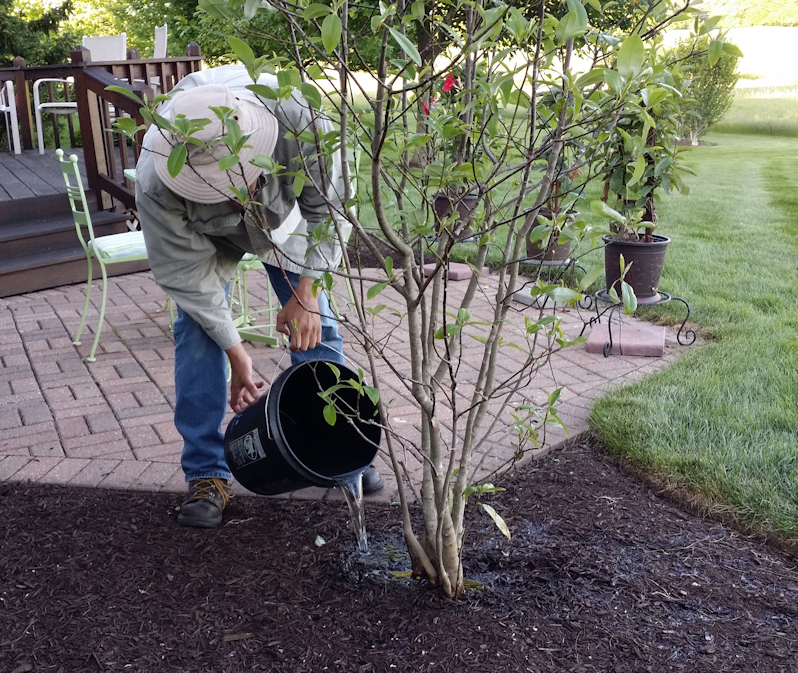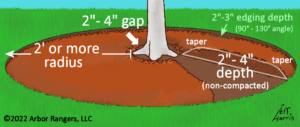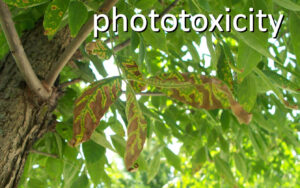Providing adequate water for your trees can be a challenge sometimes because it means you have to:
- remember to do it,
- know when & how much to do it,
- and do it in a way that doesn’t discourage you from doing it.
In this post, I hope to provide you access to some good watering tips that may make irrigating your trees easier and less inconvenient to do when you do it. Keep in mind that watering trees is based on each tree’s needs and not necessarily on a schedule. What does that mean? Well, if you have an in-ground irrigation system, chances are it is programmed to water your lawn/landscape at specific times or intervals. Have you ever driven through a neighborhood when it was raining outside and saw someone’s irrigation system sprinkling the lawn? Yep. That’s watering on a schedule and not on needs. So, you will have to physically go out into your landscape (or persuade/hire someone else to do it) to check the soil moisture of your most valued plantings, if you are interested in the best care for them.
The most susceptible plants to succumb to heat & drought stress:
- New transplants (less than 3 years)
- Improperly planted (too deep, unremoved burlap & wire, etc.)
- In or near heat islands (parking lots, roadways, etc.)
- In non-irrigated and upper slope sites
- Unplanted stock (containerized, balled & burlapped, etc.)
- Anywhere where sufficient hydration is lacking
First, here are links to a couple of “how-to” videos by Lindsey Purcell (Urban Forestry Specialist at Purdue University) on how to select quality trees and how to properly plant and care for them. These videos are loaded full of the latest research and industry practices derived from decades of research (and trial & error) from the tree care industry.
*In the second video, Lindsey offers a tip on how you can quickly calculate how much you should water your tree. (That discussion begins exactly 5:00 minutes into his video and he describes the “5 x 5” Rule.).

Methods and opinions on how frequently and how much to water will vary a bit depending on who you ask, but I’ve found they all generally lead to about the same results and your trees won’t question you on the difference anyway! And so, whether you use an in-ground irrigation system, or attach a sprinkler head to a garden hose, or fill up buckets of water with a hole at the bottom to sit at the base of your trees allowing the slow trickle to reach a lot of the absorptive roots located there, there are many ways to get water to tree roots. Use the method that best suits your time and circumstances. Adding mulch (about 2″ – 4″ deep non-compacted) can help retain moisture and save you a lot of repetitive watering time, but be sure not to pile up mulch against the trunk and flare to minimize decay, rot and girdling roots around the trunk and root flares.
Another watering system setup you could try is installing soaker hoses, which can be found very inexpensively in most home & garden stores, Lowe’s, Home Depot, Walmart, Target, etc., even Amazon. Get the length that best suits the needs of your trees. Let the hose encircle your tree, about 8″-10″ away from the base of the trunk flare. You can have it wrap around in a circle more than once, like a cinnamon-swirled pastry, to provide water more quickly to the area. Secure the hose so it doesn’t bunch upon itself by using small stakes to separate each loop of the hose or try using sod staples. Leaving the soaker hose in place all season will make it so you only have to attach your garden hose to it when it’s time to water your tree(s) during the growing season. You conceal the soaker hose by simply adding a light layer of mulch atop it.
CAN YOU WATER A TREE TOO MUCH?
Yes. And that can be just as bad for your trees as not watering them enough. Tree roots need oxygen and too much water over a period of time could suffocate them and eventually lead to a root rot problem. Therefore, in following any of the watering methods discussed previously, be sure to only water according to the needs of your trees which includes checking the soil moisture BEFORE applying additional water. It’s okay to have a schedule, but the schedule is to CHECK soil moisture and If the soil is already moist, then DO NOT apply additional water.
Reminders:
- MULCHING AROUND TREES – Don’t forget that you need to check the mulch at least annually to monitor for new girdling roots, etc. (See: “Girdling Roots: The Silent Tree Killer”) Some soaker hose manufacturers may recommend removing them before winter’s freezing temperatures arrive because moisture retained in the hose may cause it to crack. Therefore, you may have to remember to reinstall the soaker hose the next spring.
- TREE TREATMENTS – If your trees are to receive (or recently received) any treatments to provide supplementary nutrients or to suppress insect pests infestations or disease infections, etc. then you need to ensure you provide them adequate water. This can help to reduce the potential for phototoxicity injury. [Note: Many pesticide labels caution applicators not to use their products when temperatures exceed 89°F (31.6°C). These also carry temperature precautions for storing chemicals.]
I hope these watering tips help you in maintaining your landscape & property trees!
For even more great tips in managing your trees, we endorse the publication “Tree Owners Manual” made by the USDA Forest Service.
Related articles:
- “Heat & Drought Stress – Will Your Trees Survive?”
- Estimating Tree Water Requirements
- Watering Schedule example from the City of West Sacremento



